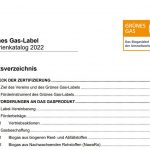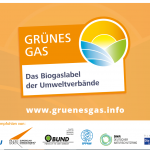Green gas
Your guide in the biogas jungle Our Grünes Gas-Label
You want to change your gas tariff, but lose the overview in the tariff comparison? When choosing your biogas tariff, look out for our seal of approval! This guarantees you environmentally friendly biogas and the expansion of renewable energies.
Guaranteed energy transition investments
A fixed amount per kilowatt hour flows into the expansion of renewable energies and into innovative energy transition projects - guaranteed!
Environmentally compatible and resource-saving
Guarantees the use of energetic potentials of biogenic residual and waste materials and the environmentally compatible production of green gases.
Supported by associations for environment, peace & consumers.
Our sponsors represent a broad social base.
Independent certification
Highest environmental standards and demanding criteria.
First seal of approval for green and biogas products
A label for the entire production chain of high-quality green and biogas.
Energy transition projects
Tariffs with the Grünes Gas-Label actively promote the energy transition.
Guaranteed energy transition investments
Investment commitment for a cross-sector energy transition: A fixed amount per kilowatt hour consumed is used to implement Energy transition projects In this way, a renewable energy future is actually driven forward - guaranteed.
More than 80 million euros have already been invested in over 1,600 ecologically valuable projects. With a biogas tariff with the Grünes Gas-Label, you support many different projects such as new eco-power plants, future technologies such as storage and smart grids, energy efficiency measures, e-mobility, citizen energy projects, etc.

Environmentally compatible and resource-saving
ENVIRONMENTALLY FRIENDLY AND RESOURCE-SAVING
Biogas with the Grünes Gas-Label usually consists of biogenic residues. In this way, biowaste becomes an energy raw material and unnecessary emissions of methane are avoided during conversion.
Decentralized energy generation:Biogas production uses biogas raw materials from the region, such as biowaste from private households, commerce and industry. Residues from agriculture, such as harvest waste, liquid manure and dung, are also turned into biogas. This is not only good for regional value creation,but also reduces dependence on fossil fuels. Biogas can be fed into the public gas grid; it can be stored, planned and controlled..

Together for the energy turnaround
Supported by associations for environment, peace & consumers.
Leading associations from civil society are behind the Grüner Strom-Label and Grünes Gas-Label. They play a key role in shaping the criteria for the labels.
Independent certification
The criteria of the Grünes Gas-Label are checked by us and an independent institute. In addition, the honorary Board of Directors reviews the expert opinions. This ensures that all criteria are assessed objectively.
The certification is based on a detailed catalog of criteria, which was drafted by energy experts and is regularly reviewed and revised by the supporting associations. The Green Gas label provides more transparency and orientation in the biogas market.

First seal of approval for green and biogas products
The Grünes Gas-Label is the first seal ofapproval for biogas and synthetically produced green gases in Germany. The Grünes Gas-Label was founded in 2013 by leading environmental, consumer and peace organizations.
The label is not issued to nuclear power plant operators or opponents of renewable energies. Investments in parent companies and subsidiaries are also included.

Obtain biogas
For a 100 percent renewable energy supply, we also need biogas. The seal of approval is only awarded to gas products that contain at least ten percent biogas.

Information material



Your contact person
Together for the energy turnaround

Michelle Markwart
Management Consultant, Online Communication
What you should know about biogas
Grünes Gas-Label
Frequently asked questions
With Green Gas-certified tariffs, guaranteed investments flow into the expansion of renewable energies.
The level of investment is determined by a fixed amount per kilowatt hour consumed. Thus, your gas purchase indirectly influences the investments in the energy transition. The areas of support include the mobility transition, energy infrastructure, energy efficiency, and other projects that serve the energy transition, such as nature conservation, development cooperation, and education.
You can find the whole range in the criteria catalog for the Grünes Gas-Label.
Biogas in general
- Biogenic residues (e.g. biowaste from the organic waste garbage can, plant residues, residues from agriculture such as harvest and slaughter waste, liquid manure, slurry and dung).
- Sewage sludge and sewage gases from wastewater treatment plants, industrial processes, or commercial production (e.g., from biogenic residues in paper recycling).
- Renewable raw materials or energy crops (e.g., corn or through-grown silphia).
The abbreviation NawaRo stands for the term renewable raw materials.
This refers to plants or plant components that originate from agricultural production and are not used as food or feed, but are used materially or energetically, e.g. for the production of biogas.
Sewage gas is a methane-containing gas produced during wastewater treatment by the digestion of sewage sludge. Sewage gas contains between 45 and 70 percent methane by volume.
As the name suggests, this is gas that is produced artificially. Gas is produced from water in an electricity-intensive process called electrolysis. This concept is called power-to-gas. In this context, people often talk about green hydrogen. Green' here means that hydrogen is produced with the help of green electricity.
- Biogenic residues (e.g. biowaste from the organic waste garbage can, plant residues, residues from agriculture such as harvest and slaughter waste, liquid manure, slurry and dung).
- Sewage sludge and sewage gases from municipal wastewater treatment plants, industrial processes, or commercial production (e.g., from biogenic residues in paper recycling).
- Renewable raw materials (e.g. maize or through-grown silphia), but only if there is an ecologically sustainable operator concept that is conducive to the energy transition.
Want to learn more?
Then feel free to contact us and follow us on social media.





